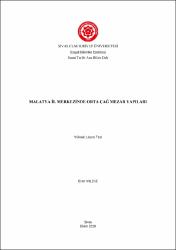| dc.contributor.advisor | Eser, Erdal | |
| dc.contributor.author | Yıldız, Eren | |
| dc.date.accessioned | 2022-04-28T09:21:25Z | |
| dc.date.available | 2022-04-28T09:21:25Z | |
| dc.date.issued | 2019 | tr |
| dc.date.submitted | 2019-10-04 | |
| dc.identifier.other | xv, 177 | |
| dc.identifier.uri | https://hdl.handle.net/20.500.12418/12585 | |
| dc.description.abstract | Anadolu'nun ilk yerleşim yerlerinden biri olan Malatya, kültürel yönden
zenginlik arz eden bir kenttir. İlk çağ ve Orta çağ’ın hakim devletleri için coğrafi
özellikleri bakımından vazgeçilmez bir konuma sahip olduğundan, Malatya'yı idaresi
altına almıştır. Uzun yıllar ellerinde tutabilmek için öncelikle kale ve surlar
onarılarak imar faaliyetlerinde bulunmuşlardır.
Şehrin sürekli işgal edilerek el değiştirmesi; birçok eserin günümüze sağlam
gelmesini engellemiş ve var olan yapıların orijinalliğini kaybetmesine neden
olmuştur. Memluklu ve Selçuklu gibi devletlerin yanı sıra Danişmendliler gibi
Beyliklerin idaresine giren Orta Çağ Malatya'sının İmar faaliyetlerine bakıldığında;
cami, mescit, medrese, türbe ve minare gibi yapıların çoğunun bu dönemde yapıldığı
görülmektedir.
10. yüzyıldan itibaren Horasan ve Türkistan bölgesinde ortaya çıkan mezar
yapıları, Anadolu'da 12.yüzyıldan itibaren yaygınlaşmaya başlamıştır. Çeşitli
formlara sahip olan mezar yapıları, Anadolu'da Türk-İslam mimarisinde kendine en
çok yer edinen yapı türlerinden birisi olmuştur.
Anadolu Selçukluları'na ait; poligonal gövdeli, silindirik gövdeli, kübik
gövdeli, eyvan tipli, dikdörttgen planlı (v.s) türbelerin yanı sıra Beylikler ve Erken
Osmanlı döneminde yeni bir tür olarak ortaya çıkan baldaken tipli birçok türbe;
Anadolu'nun çeşitli yerlerinde inşa edilmiştir. Bu yerlerden biri olan Malatya'da var
olan Türk-İslam yapıları arasında Selçuklular'a ait yapılar da mevcuddur. Battalazi
ilçesinde mevcud yapıların arasında Orta Çağ dönemine ait türbeler de
bulunmaktadır. Ancak bu türbelerin kitabesiz olması nedeniyle banileri ve inşa
tarihleri bilinmemektedir.
Malatya'daki Türk-İslam dönemi yapıları hakkında yapılan bireysel ve
kurumsal çalışmalar incelendiğinde, hemen hemen hepsinde aynı sorunla
karşılaşıldığı görülmektedir. Yapılan çalışmalarla birlikte aynı plan tipindeki diğer
yapılarla malzeme ve teknik yönünden değerlendirilerek tarihlendirme yoluna
gidilmiştir. | tr |
| dc.description.abstract | Malatya, one of the first settlements in Anatolia, is a city that is rich in
cultural aspects. Since it has an indispensable locaiton due to its geographic features
for rulling states of First Age and Medieval Age, these states held the administration
of Malatya. For the purpose of keeping this city in their hands for many years, they
engaged in the zoning activities by repairing the castles and city walls.
The fact that the city had passed in other hand with invasion, prevented many
Works from surviving to the present and caused the existing structures to lose their
originality. When the zoning activities of Medieval Age's Malatya, which came
under the administration of the the states such as Mamelukes and Seljukians along
with beylics such as Danishmends are observed; it is seen that most of the structures
such as mosque, small mosque, madrassah, tomb and minaret were constructed in
this period.
This grave structures taht emerged in the region of Khorasan and Turkestan
beginning from 10. century, has become common in Anatolia in 12. century. The
grave structures that have various forms, have become one of type of structures that
gain a seat in Turkish-Islamic architecture in Anatolia. A large number of tombs with
baldachin type emerged as a new form in Period of Beylics and Early Ottoman in
addition to the tombs with polygonal body, cylindrical body, cubic body, iwan type,
rectangular plan (etc) which belongs to Anatolian Seljukians were constructed in
various places of Anatolia.
There are structures which belong to the Seljukians amongst the Turkish-
Islamic structures existing in Malatya, one of these places. There are the tombs
which belongs to Middle Age, amongst the structures located in Battalgazi.
However, the constructives and construction dates are unknown since these tombs do
not have inscriptions.
When the individual and institutional studies about Turkish-Islamic structures
in Malatya are examined, it is seen that the same problem is encountered in almost
all of them. Together with the studies conducted, they are dated by evaluating them
with other buildings with the same plan in terms of material and technique. | tr |
| dc.language.iso | tur | tr |
| dc.publisher | Sivas Cumhuriyet Üniversitesi-Sosyal Bilimler Enstitüsü | tr |
| dc.rights | info:eu-repo/semantics/openAccess | tr |
| dc.subject | Kırk Kardeşler | tr |
| dc.subject | Mezar | tr |
| dc.subject | Türbe | tr |
| dc.subject | Malatya | tr |
| dc.subject | Battalgazi | tr |
| dc.title | Malatya İl Merkezinde Orta Çağ Mezar Yapıları | tr |
| dc.type | masterThesis | tr |
| dc.contributor.department | Sosyal Bilimler Enstitüsü | tr |
| dc.relation.publicationcategory | Tez | tr |















